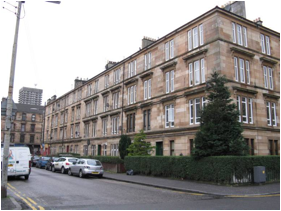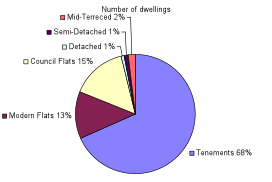One of the most obvious areas to look into when trying to reduce a carbon footprint of a community is demand reduction. The domestic sector, along with industry, is one of the biggest contributors of carbon emissions.

Figure 1: Typical 4 storey tenements in Dennistoun
A housing stock survey was carried out on the number and type of housing in the area, the results of which are summarised in Figure 1 below. The survey found that the majority of dwellings are three or four storey blocks of tenement flats, like the ones in Figure 1. These are predominantly sandstone structures that date back to the 19th and early 20th century. There are also council flats in the area as well as modern flats, again both three and four storeys. There are also a few streets of detached, semi–detached and mid–terraced housing, all of which are pre-1981.
Intermediate Geography Zone (IGZ) data for the area of investigation shows that there are 3200 dwellings in the area, which matches closely with the results of the housing survey. The full housing survey can be found in the downloads page.

Figure 2: Graph showing breakdown of housing stock in the area.
The analysis carried out on domestic improvements can easily be transferred to other areas of Glasgow and many other cities in Scotland. This is especially so in the inner cities as tenement buildings are prominent. The results from the study (highlighted in the next sections) show significant carbon savings and reduction in consumption can be made in the domestic sector. This system could also be applied to areas with detached, semi detached and mid terraced housing.